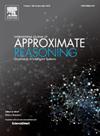Maximal hypercliques search based on concept-cognitive learning
IF 3.2
3区 计算机科学
Q2 COMPUTER SCIENCE, ARTIFICIAL INTELLIGENCE
引用次数: 0
Abstract
Maximal hyperclique search, focused on finding the largest hypernode subsets in a hypergraph such that every combination of r nodes in these subsets forms a hyperedge, is a fundamental problem in hypergraph mining. However, compared to traditional graphs, the combinatorial explosion of hyperedges significantly increases the complexity of enumeration, especially as the r-value and the number of hypernodes grow, rapidly expanding the search space. Moreover, overlapping hyperedges in dense hypergraphs lead to substantial redundant checks, further exacerbating search inefficiency, making traditional methods inadequate for large-scale hypergraphs. To tackle these challenges, this paper proposes a novel approach MHSC that handles the maximal hyperclique search task in r-uniform hypergraph based on concept-cognitive learning. Concept-cognitive learning refers to the process of understanding and structuring knowledge through the formation of concepts and their interrelationships. Technically, the hypernode-neighbor structure of the hypergraph is first expressed as a formal context, and the required concepts are generated using the concept lattice algorithm. Based on the shared relationships between hypernodes represented by the hyperedges, a series of theorems are proposed to prune hypernodes that cannot form maximal hypercliques within the sets of 1-intent and 2-intent concepts, thereby narrowing the search space and reducing redundant computations. Furthermore, an optimization method termed MHSC+ is introduced. Extensive experiments conducted on both test datasets and real-world datasets demonstrate the effectiveness, efficiency, and applicability of the proposed algorithm.
基于概念认知学习的最大大集团搜索
最大超边搜索主要是寻找超图中最大的超节点子集,使得这些子集中的每一个r节点组合都能形成一个超边,这是超图挖掘中的一个基本问题。然而,与传统图相比,超网格的组合爆炸大大增加了枚举的复杂性,特别是当 r 值和超节点数量增加时,搜索空间迅速扩大。此外,密集超图中重叠的超节点会导致大量冗余检查,进一步加剧搜索效率低下的问题,使得传统方法无法满足大规模超图的需求。为了应对这些挑战,本文提出了一种基于概念认知学习的新方法 MHSC,用于处理 r-uniform 超图中的最大超角搜索任务。概念认知学习是指通过形成概念及其相互关系来理解和构建知识的过程。在技术上,首先将超图的超节点-邻接结构表达为形式化的上下文,然后利用概念网格算法生成所需的概念。根据超图所代表的超节点之间的共享关系,提出了一系列定理,以剪除不能在 1-entent 和 2-entent 概念集合内形成最大超环的超节点,从而缩小搜索空间,减少冗余计算。此外,还引入了一种称为 MHSC+ 的优化方法。在测试数据集和实际数据集上进行的大量实验证明了所提算法的有效性、高效性和适用性。
本文章由计算机程序翻译,如有差异,请以英文原文为准。
求助全文
约1分钟内获得全文
求助全文
来源期刊

International Journal of Approximate Reasoning
工程技术-计算机:人工智能
CiteScore
6.90
自引率
12.80%
发文量
170
审稿时长
67 days
期刊介绍:
The International Journal of Approximate Reasoning is intended to serve as a forum for the treatment of imprecision and uncertainty in Artificial and Computational Intelligence, covering both the foundations of uncertainty theories, and the design of intelligent systems for scientific and engineering applications. It publishes high-quality research papers describing theoretical developments or innovative applications, as well as review articles on topics of general interest.
Relevant topics include, but are not limited to, probabilistic reasoning and Bayesian networks, imprecise probabilities, random sets, belief functions (Dempster-Shafer theory), possibility theory, fuzzy sets, rough sets, decision theory, non-additive measures and integrals, qualitative reasoning about uncertainty, comparative probability orderings, game-theoretic probability, default reasoning, nonstandard logics, argumentation systems, inconsistency tolerant reasoning, elicitation techniques, philosophical foundations and psychological models of uncertain reasoning.
Domains of application for uncertain reasoning systems include risk analysis and assessment, information retrieval and database design, information fusion, machine learning, data and web mining, computer vision, image and signal processing, intelligent data analysis, statistics, multi-agent systems, etc.
 求助内容:
求助内容: 应助结果提醒方式:
应助结果提醒方式:


